Attention
Elizabeth McTernan
Related terms: absence, Arctic, biology, climate breakdown, counting, embodiment, hyperobject, inventory, landscape, Lapland, narrative, observation, presence, scale, scientific gaze, situatedness, thick present, tools
Paying Attention
Choosing to give one’s attention to something or someone is like placing a frame around a moment in time and focusing on its contents. It is not incidental but deliberate. In the contemporary Western paradigm, ‘attention’ is difficult to separate from the attention economy: a system in which human attention is viewed in terms of scarcity, as a resource to be weighed and traded. One ‘pays’ attention if something is ‘worth’ their attention. But ‘attention’ can also be an act of care, or witness. It can be the presence that precedes and informs a story of encounter to be recounted later, or an act of curiosity that holds open space for a waiting-to-see. The frames through which we give our attention are critical and deserve attention themselves. They focus and edit, they emphasize and obscure, and they are intentional and accidental in how they draw attention towards and away.
Grid as Container for Attention
Humans have a habit of deploying grids to discipline unruly content, but the grid can also be used to call attention to something that is otherwise unexamined. In beginner art classes, one of the first things students learn when practicing observational drawing is how framing a subject by placing a square viewfinder or grid between themselves and the subject helps to corral the artist’s visual attention while they compose an image. Artistic practices over the last century have foregrounded the grid for a multitude of formal and conceptual purposes: to establish order, seriality, and rhythm; to challenge visual hierarchy, to flatten the picture plane, to delimit, and to direct the viewer’s gaze in a certain way. One hazard of the grid as a superimposed field is that it can resist context and narrative to suggest ‘a world apart’ from reality (Krauss 1985, 1). It can also foreshadow extraction: of information, of resources. But a framing grid can also sensitize a person to something overlooked; it can have meaningful consequences for perception, relation, and attention.
Grids are deployed in field sciences as well. For example, they are used to frame landscapes or fields of vision to count flora and fauna populations. One common method used by field biologists to count animal populations is to mark off a series of squares, called ‘quadrats,’ in the landscape and observe wildlife passing through them for fixed time periods and intervals. Often, instead of using automated sensors or algorithmic image analysis, scientific observation relies on the naked human eye, the primary lens for examining landscapes, wildlife, and others. The human body is a subjective measuring apparatus, collecting data with its attention. I have used grids in my own artistic field experiments over the years, some of which I will detail below.
While researching for a project, I heard a rather whimsical approach to population sampling from wildlife biologist Cristina Dressel at Oregon State. Her task one summer was to assess a butterfly population by taking samples out in the landscape. Her method was to walk out to a single pre-selected spot in a meadow at the same time every day for several weeks in a row. When she arrived at that spot, she would take out her butterfly net and recreate the same gesture each time, swooping the net in front of herself in an arc from right to left as the soft grid enveloped everything in its path. Afterwards, she would count the butterflies she caught with that one gesture and note the number, even if it was zero. Any other critters caught were not counted. After the sampling period was complete, the data provided an approximate population count for that butterfly species, not just in that region, but also at her specific human height and arm span. The situated bodily gesture of a human defined the population of another species. Discussing similarly subjective methods, Dressel said:
Yeah, it’s fascinating the way that human error is involved. I have friends who count marbled murrelets, which are birds that only fly at dusk. They hike through steep, wet terrain and then lie on their backs and just count anything that crosses their vision. They might count one murrelet, or two, in a summer. But imagine if they miss some because they’re bored, or tired, or looking away to get a snack, or can’t see clearly because it’s dusk. The difference between zero and one is huge... It’s presence versus absence. (email message, 15 December 2016)
Here, on one hand, the uniformity of position, gesture, and view lends the research practice reproducibility, which bolsters scientific credibility. On the other hand, the frame also inescapably includes the inherent specificity and arbitrariness of the researcher’s position, range of motion, and range of vision. Is an encounter with a marbled murrelet any more a matter of calculated probability than it is a welcome accident facilitated by the methodical frame? While the method of witness in the field described above is direct and free of external apparatuses, it is still mediated by the human body and sensorium: by eyes that are not evolved for dim light conditions, by degrees of comfort or discomfort of lying on one’s back, by the mind’s capacity for recognition, and by a variable attention span. Not to mention the human form or chemical signature of the observer that might call attention to itself enough to deter the presence of the nonhuman subject. The method is as organic and tenuous as it is rigorous.
Where the Circle Bends the Grid
It takes a long time to get to Kilpisjärvi Biological Station: leaving from Helsinki, in the very south of Finland, it is a night train up to Rovaniemi, on the Arctic Circle, where Santa Claus has a mailing address, and then another seven hours on a post bus following a squiggly road northward to the sharp corner where the borders of Finland, Sweden, and Norway all meet, in the Sápmi region of Lapland. Looking at a map of the region, one can see a grid compromised by Lapland’s proximity to the top of the globe, longitudinal lines starting to veer towards each other as they approach their pinch point at the North Pole. Out in the field, one can see long straight stretches of international border-fencing crisscrossing the tundra, absurd lines in a region defined by fluid movement (Figure 1). Sámi reindeer herders and their animals must negotiate the gates that perforate these borders delineated by nation and taxation. On the Finnish side, because of these divisions, the reindeer, well insulated for Arctic winter, can no longer reach their historical grazing grounds at higher elevations during the warm season, which would normally protect them from overheating. Corralled away from the Norwegian highlands, this is both a danger to their health and totally maddens the botanists studying local flora in the lowlands, which often involves laying string grids over small areas of plant life to be quantified, such as bilberries (Bovermann 2023). Many researchers – understandably – blame depletion of indigenous vegetation on the reindeer’s overgrazing. When I arrived in Kilpisjärvi, I thought to myself how peaceful it seemed. Then all the stories started to texture the tundra with as much more-than-human drama as any city.
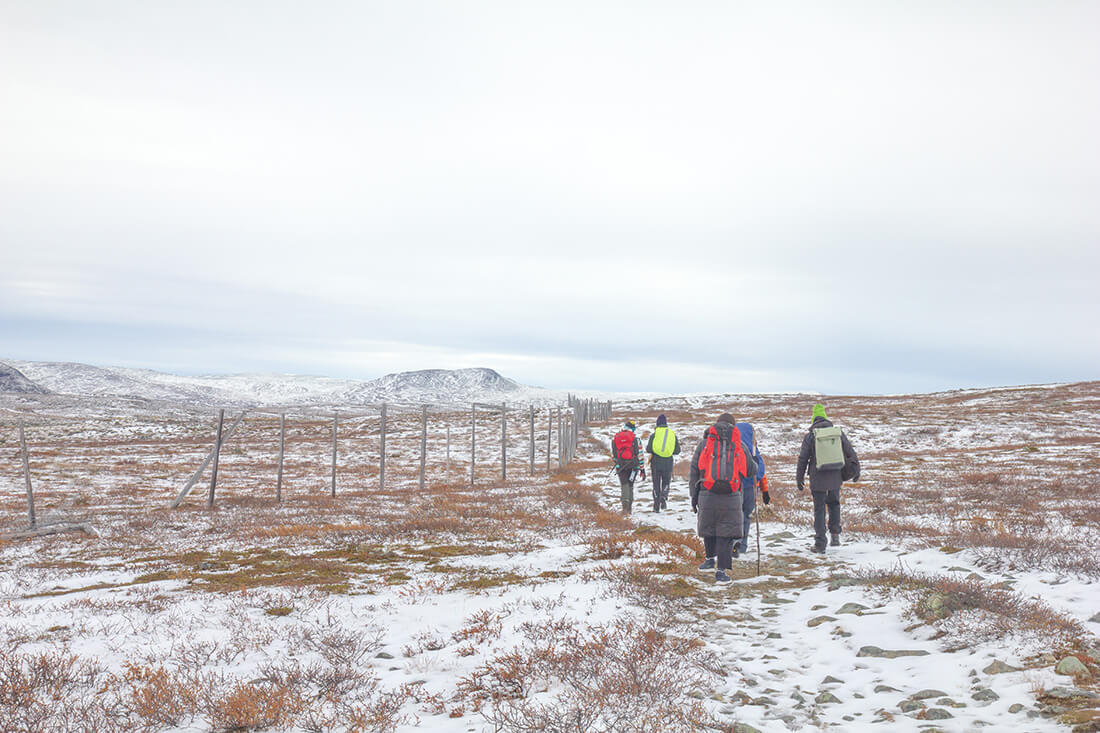
Seeing Things
I have spent time at Kilpsijarvi Biological Station twice, first in 2017 and again in 2023. My first time was as an artist in residence at Ars Bioarctica, which was, and still is, organized by the Bioart Society in Helsinki and hosted by Kilpisjärvi Biological Station. That June, I made the journey north with my collaborator, mathematician Luke Wolcott. We lived at the station for several weeks alongside botanists, zoologists, and geologists, as well as other ologists whom we only encountered indirectly by way of their cryptic equipment scattered across the landscape.
Luke and I called our residency project Seeing Things: we were there to examine and record our own subjective experiences of looking at, waiting for, and counting wildlife – especially lemmings, which are famously abundant in Lapland. I explained to our Finnish counterparts that the phrase ‘seeing things’ has a figurative meaning in English: it refers to hallucination, to seeing what is not really there. Subjective impression is misrecognized as an objective representation, such that the inside of the observer becomes the outside being observed. The point of departure for our research was the role that looking plays in science, particularly the way that the subjective act of counting – in all its inherent imperfection – forms the empirical basis for objective knowledge and data collection, and how the state of an ecosystem is conceptualized from data collected by humans witnessing other species in the field.
Our project was designed to pose questions to that looking; what is the significance of human witness – attention – to the state of ecology in marginal landscapes? What are its limitations, and what are the stakes of not paying attention, of not seeing, or of simply losing count? What stands to be lost? What stands to be gained through knowledge accumulated by embodied counting in an age when we rely on abstract quantifications to maintain a sense of truth and ecological orientation? What if the scientific gaze, turned outward, ends up merely recording itself? What if it is, in a phrase, seeing things?
Absence versus Presence
Luke and I planned observation periods during which we would take notes on our subjective experiences of waiting and watching – our embodiment in the observation process. We hiked out from the biological station grounds, and on the high, barren slopes of Saana, we roped off five 25-square-meter quadrats on the ground as case areas (Figure 2). Then, for five bright nights around the summer solstice, we each took a two-hour shift observing these case areas, one per night. Each quadrat was observed for a total of four continuous hours. The post from where we made the observations was a blanket on which we sat upright, facing the assigned quadrat. We had four protocols: 1) we would each conduct our respective two-hour observation periods alone and in silence; 2) we would each observe from the same post and not move from that position for the full two-hour interval; 3) we would each keep our eyes focused only within the square and not let our eyes wander outside of it during the observation period; and 4) we would each take notes in a shared field notebook on our basic, unanalyzed observations, such as the weather, our position, our disposition, and activity within the square. Slowness was key, as was resistance to the desire to determine ‘what it will be good for’ (Stengers 2018, 109). We wanted to see things for ourselves from our own bodies in place, to sit in the pre-numerical scene of quantification.
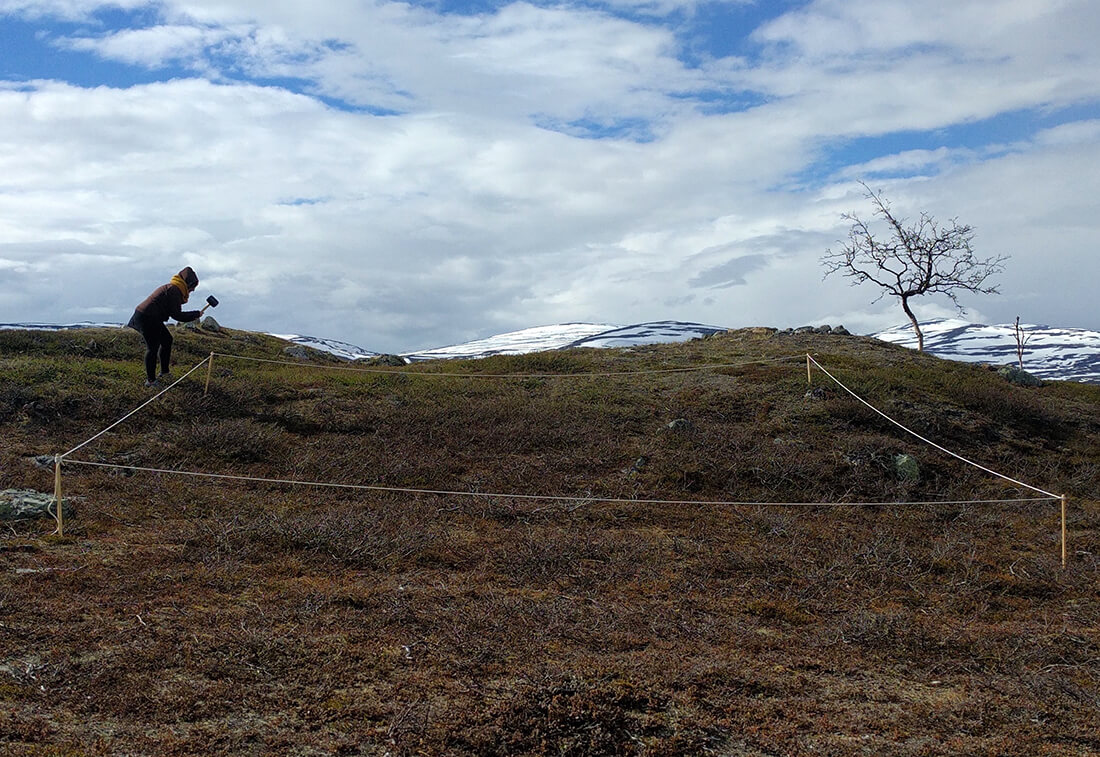
During our sessions, the quadrats were couched in a context of a warming world. We were watching whatever happened within the squares in overlapping timescales. It occurred to me that we were observing climate change unfold on a large scale that was imperceptible to us in the moment, while, in an immediate sense, our seated bodies heated the earth directly underneath us. During my first observation session, somber thoughts erupted in the space between my brain and the quadrant: of environmental apocalypse, of the role humanity plays in determining the fate of common and endangered species alike. In our cumulative action or inaction, we are, de facto, deciding the species’ presence or absence. Thoughts like these made it clear to me that counting, generally, and counting wildlife, specifically, is an investigation into the question of presence or absence. A field researcher goes forth into the landscape in the hope that their own arbitrary presence will meet another species’ chance presence, so they can add a tally to indicate ‘this being was here’ and build a picture to argue ‘this being should be here.’ That human body at attention determines future human attention and care.
The North Escaping
In autumn 2023, I was invited back to Kilpisjärvi Biological Station to lead a group in the sixth edition of Field_Notes, an art-science field laboratory organized by the Bioart Society biannually since 2011. For the 2023 edition, titled ‘Field_Notes: The North Escaping,’ three groups of five artists came together from all over the world and worked in Lapland for two weeks, developing, testing, and evaluating interdisciplinary approaches to exploring landscape under the theme of ‘The North Escaping.’ As a host, I wrote a framing abstract (McTernan 2023) and selected the artists for my group. The idea behind ‘The North Escaping’ was to see what artistic positions and methods emerge from working in a precarious northern landscape under climate breakdown. All year round, scientists there take measurements of the landscape – temperature, proportions of particles in the atmosphere, carbon counts, and so on. How might artists approach those tools differently? Or ask very different kinds of questions than scientists? What other kinds of attention might they bring to an observational encounter? This was not a project about turning artists into pseudo-scientists. It was about bringing artistic practice side-by-side with scientific practice and seeing what discourses would emerge and what new knowledge structures could develop.
‘The north escaping’ means permafrost receding, tree lines rising, and flora milieus reconfiguring as the seasons warm. ‘The north escaping’ means stories outgrowing and spilling over our grids, our map lines, our boxes. ‘The north escaping’ is the threat that a vast reality is withdrawing from our human senses into a realm of abstraction. How do we bring it close rather than accept its withdrawal? Philosopher Timothy Morton coined the term “hyperobject” to refer to things that are so “massively distributed in time and space relative to humans” as to be ungraspable to our perception (Morton 2013, 47). How do we push against the contemporary sublime of the hyperobject, which is another means of storying climate breakdown as too big, too inaccessible, too alienating for a person to enter? How do we meet Timothy Morton’s “scalar dilemmas” (Morton 2013, 47) – caused by the limitations of human space- and time-scales – with our attention and stay with the notion that we can only start from where we are, that the world is here and not over there? When I returned to Kilpisjärvi, I kept Donna Haraway’s words close:
You have to constantly keep writing this particular story – not some story in general, but this story. You have to do this; you have to be here, not everywhere. You have to be attached to some things, not everything (Terranova 2016).
Attention is intentional and directional. Attention requires presence and specificity. It is hospitable to the narratives that shape connection, and the care those stories carry. It can also be greedy, irrepressibly haphazard, arbitrary, predatory, accidental, fluid, error-laden, and subject to coercion. Here, I choose to focus on attention concerning relation and care, to provide a modest tool to think along with towards kinship rather than alienation or despair, which are already always in attendance.
Grid as Scientific Tool
Early on in the 2023 field laboratory, we were introduced to some of the scientific methods being used to make measurements out in the field. Hannu Autto, the coordinator of the biological station, introduced us to a very cool project underway, called ‘LIFEPLAN: A Planetary Inventory of Life,’ led by the University of Helsinki. Kilpisjärvi is home to one of 127 global sampling stations that are monitoring the Earth’s biodiversity using various instruments (LIFEPLAN 2025).
Not far from the station, Autto showed us around the equipment that is installed in the field year-round within multiple roped-off quadrats: a pole with a microphone that records and uploads audio continuously, and below that a motion-sensitive camera (Figure 3). Both are positioned above the expected snow level, where wildlife is most likely to trigger it as the many chapters of Arctic winter unfold. There is a souped-up anemometer instrument, measuring wind speed, wind direction, and air pressure (Figure 4). It also collects air samples in glass vials so researchers can study the concentration of certain particles in the atmosphere, using the invisible to build a picture of how the region is changing under climate breakdown.
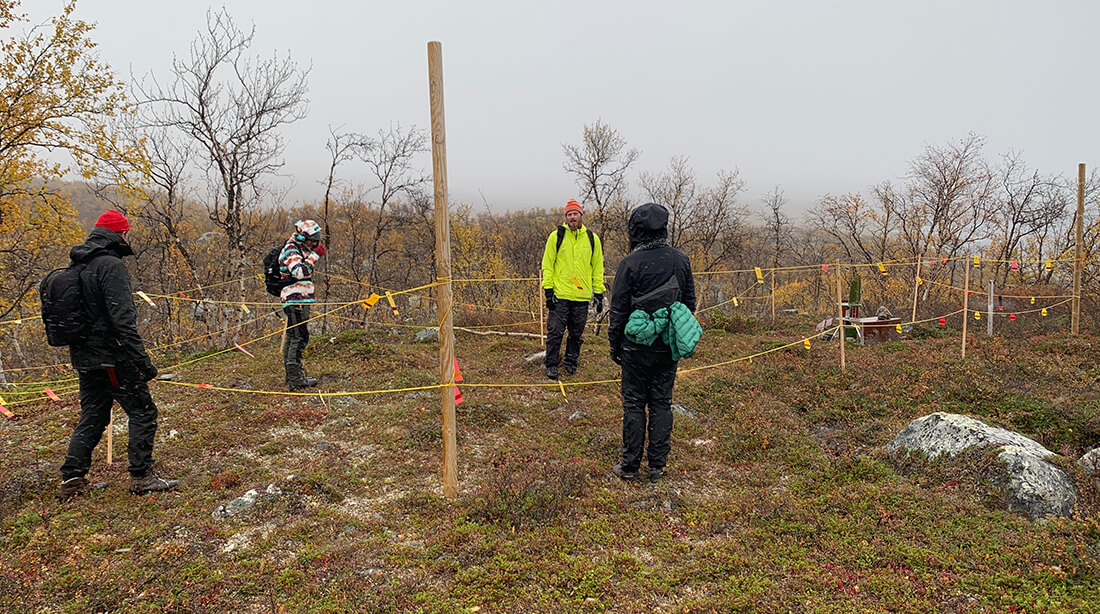
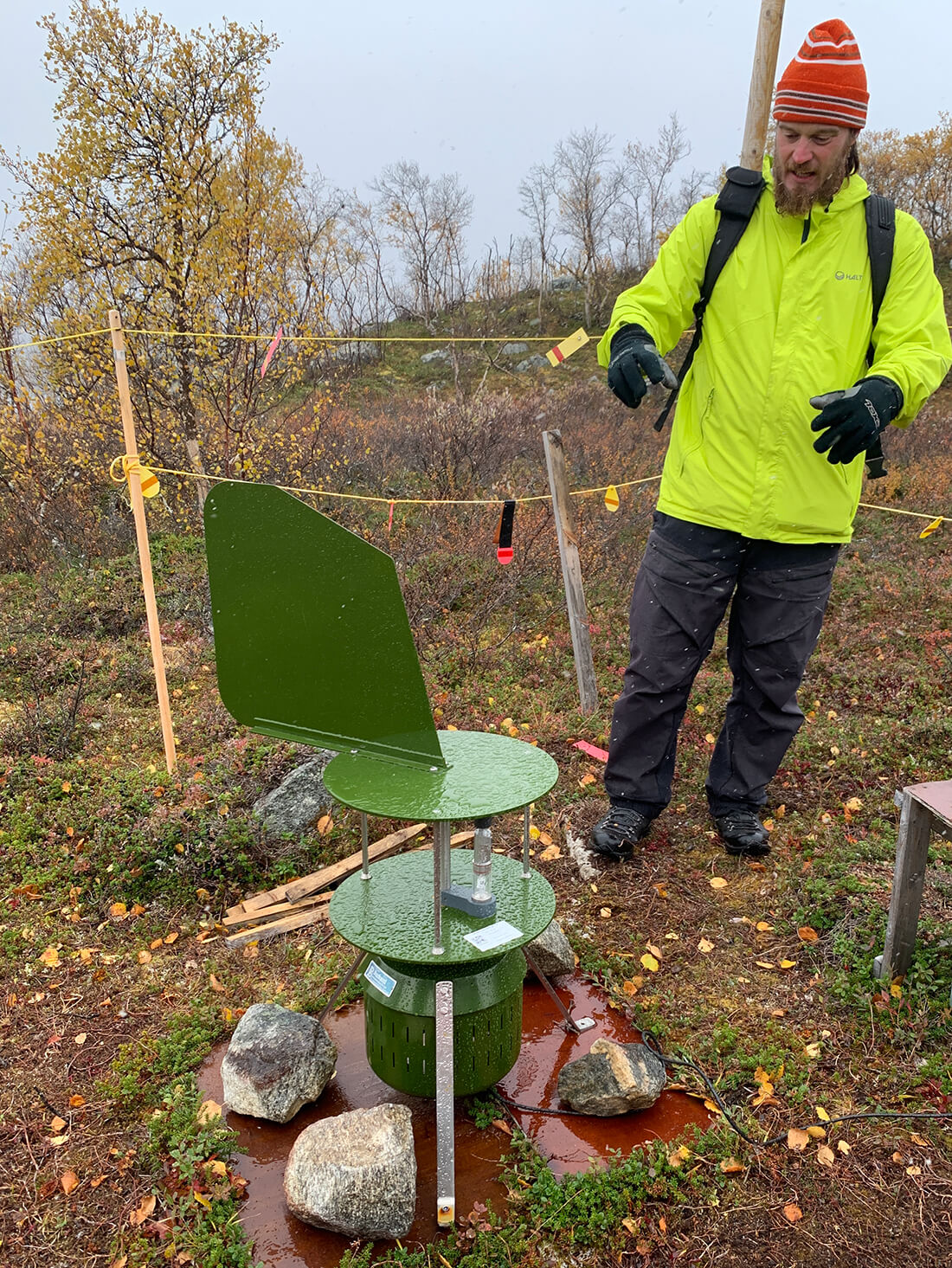
Each station, setup, and protocol is identical across the 127 locations; it is the landscapes that vary widely. By design, there is no ideal setting for a LIFEPLAN sampling station, no prerequisite of ‘pure’ nature. The locations are scattered across continents – in wilderness, rural, urban-rural, suburban, and urban spaces. Each station is here, not everywhere, and all those ‘heres’ add up to an imperfect but handy picture of the heterogeneous and entangled life on Earth. Perhaps a project of such planetary specificity and scope can provide a container for attention – large-scale but grounded.
Invisibility Mistaken for Absence
Essential to understanding a landscape are the narratives that carry through it. Of all the tools I was introduced to in Kilpisjärvi in autumn 2023, narrative struck me as the most powerful and was often the difference between seeing and not seeing the defining features of the wilderness. My Field_Notes group and I had the privilege of taking a hiking tour in the region with Leena Valkeapää, a local artist and Bioart Society mentor living nearby. She is married to a local Sámi reindeer herder, Oula Valkeapää, who is also beloved by the artists and scientists who have spent time at the station. Valkeapää has described herself as having one foot in each world – that of southern Finland, where she grew up, and that of the Sámi in the north.
Valkeapää is a generous and critical guide. At one point on our hike, she gestured to an area behind her, asking us, ‘Can you see how intense this area of the landscape is?’ (Figure 5). None of us could. To our untrained eyes, this was not a location we would have even paused at, just an empty stretch of field between a wood and a lake. In fact, I distinctly recall my mind was already at the lake up ahead – a much more charismatic landscape feature that I was looking forward to framing with my camera. Valkeapää explained that this ‘intense area’ had vegetation that was dramatically different from neighboring areas, because it had once been a Sámi reindeer corral. In response to our not seeing, she said:
The thing about these areas, where so many nomadic people and their reindeer have come and gone over centuries without building any permanent structures – not even firepits – is that, if you want to forget, it’s very easy to forget. So if the culture or the government doesn’t want to see the history here, it’s easy not to see (conversation in the field, September 2023).
With that statement, I realized how powerful narrative is as a tool for reading, misreading, remembering, or forgetting the Lapland landscape. The presence – or absence – of that history hinged on hearing a story.
Grids can be deployed as atemporal geometries, but they still frame thick places of movement and histories. The bilberries in Kilpisjärvi grow up and over their string grids in summer, literally resisting the grid’s flattening effect. Meanwhile, I only noticed them then and remember now the bilberries because I stumbled upon their grids in the forest years ago, which made me stop and give attention to their contents. Those bilberries are part of this story now. Whatever happened to exist alongside them, I don’t recall.
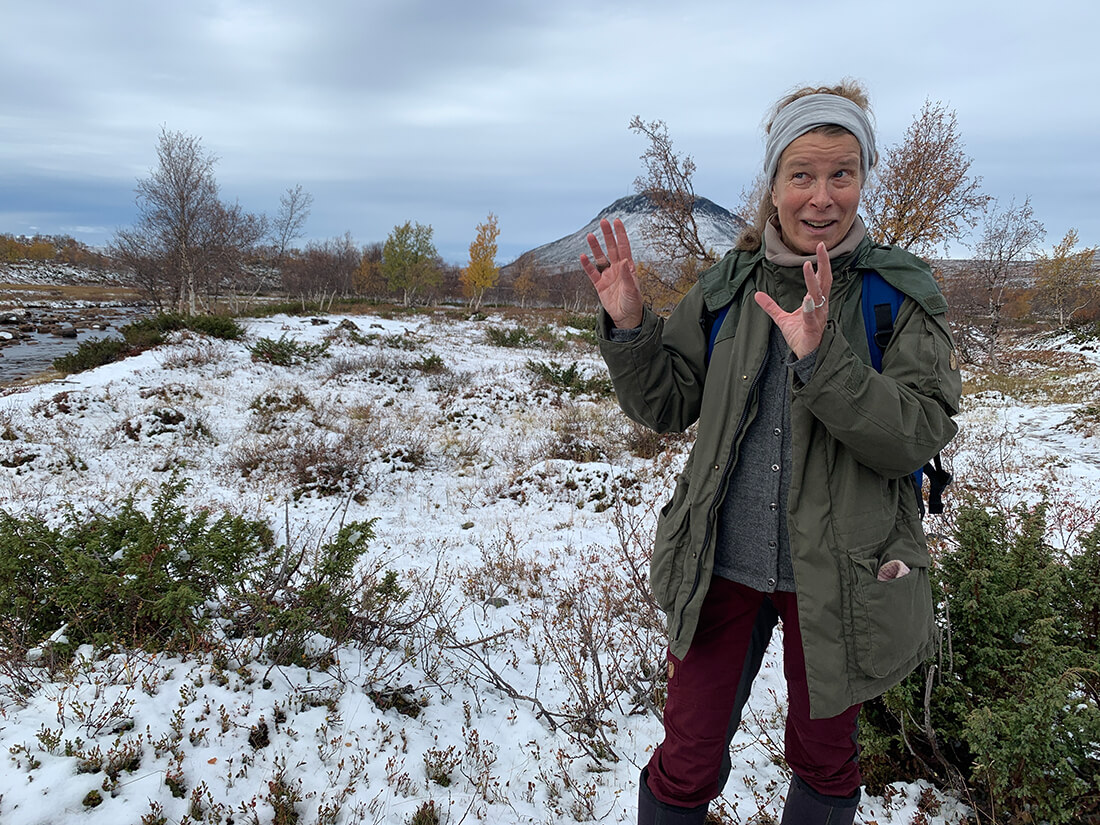
Grid as Shape for Attention
Towards the end of Field_Notes, my group and I spent an intensive period of two days doing experiments in an area not far from the biological station, maybe a 45-minute walk. During those two days, I roped off several squares in the landscape: 5 x 5 m, 2 x 2 m (Figure 6), 1 x 1 m, 10 x 10 cm. I gave everyone a prompt: ‘What is the scale of your attention?’ I then invited them to observe the quadrats using their own multidisciplinary approaches.
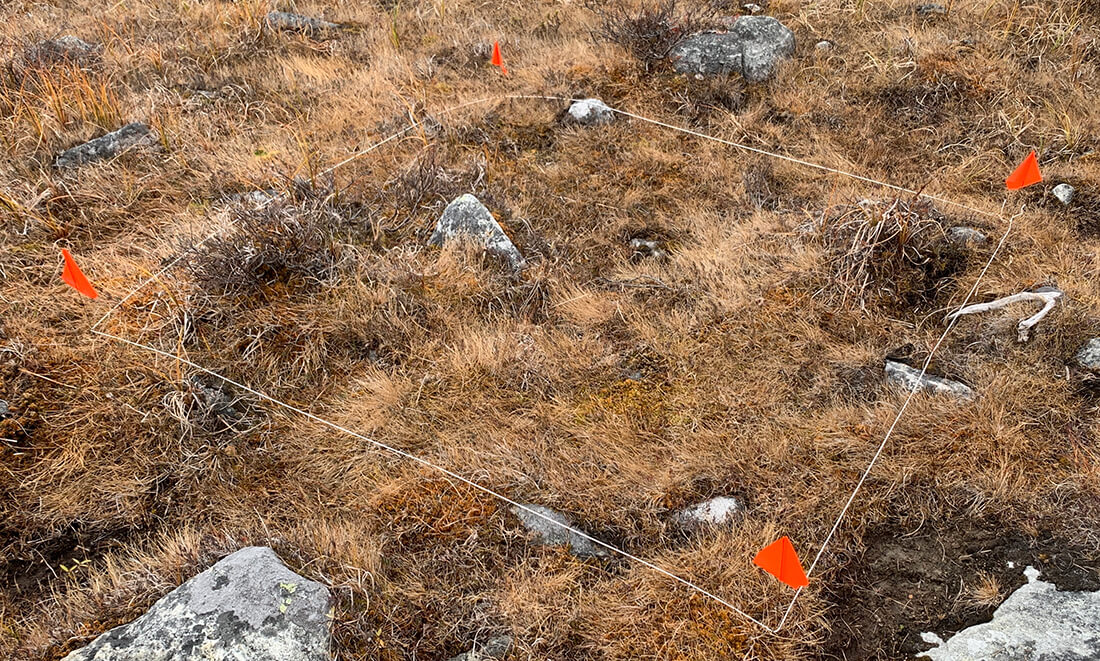
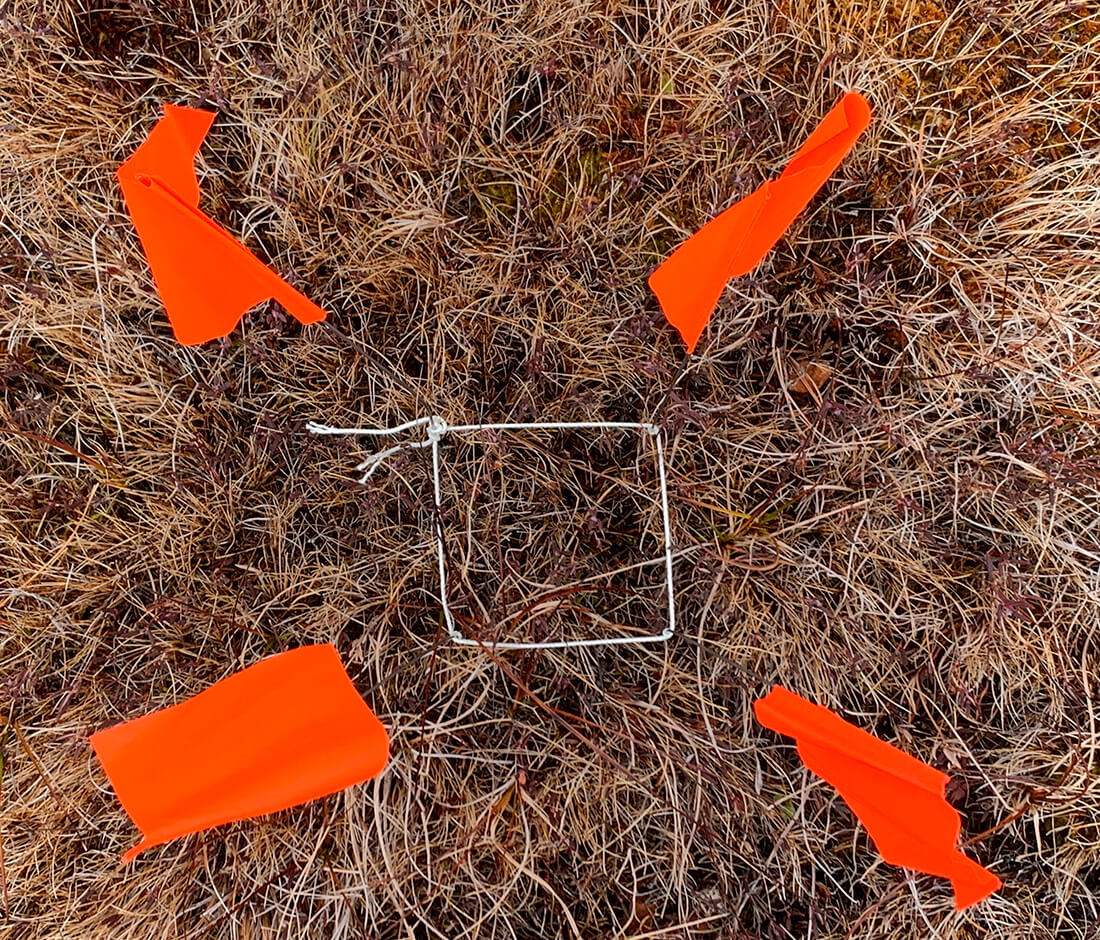
Sound artist John Grzinich set up a contact mic in the 10 x 10 cm area (Figures 7, 8), and we took turns listening to the vibrations being transmitted by the short grasses in the breeze. Leena Lehti, a Finnish artist, created much smaller frames, 1 x 1 cm (Figure 9). Instead of using a string, she made paper cutouts. She extracted content from the areas within her squares and returned to the wet lab to take microscopic photographs (Figure 10). Laure Winants, who describes herself as a field-based visual artist, lay on her back within the biggest quadrat, the 5 x 5 m (Figure 11), and, looking up at the sky, noted how the presence of the square drawn around her shifted the way she imagined herself in the square and how she further imagined the square in the map (in her mind’s eye), from an aerial view. In a sense, her perspective from her body within the quadrat both precipitated and collapsed into the perspective of the map.
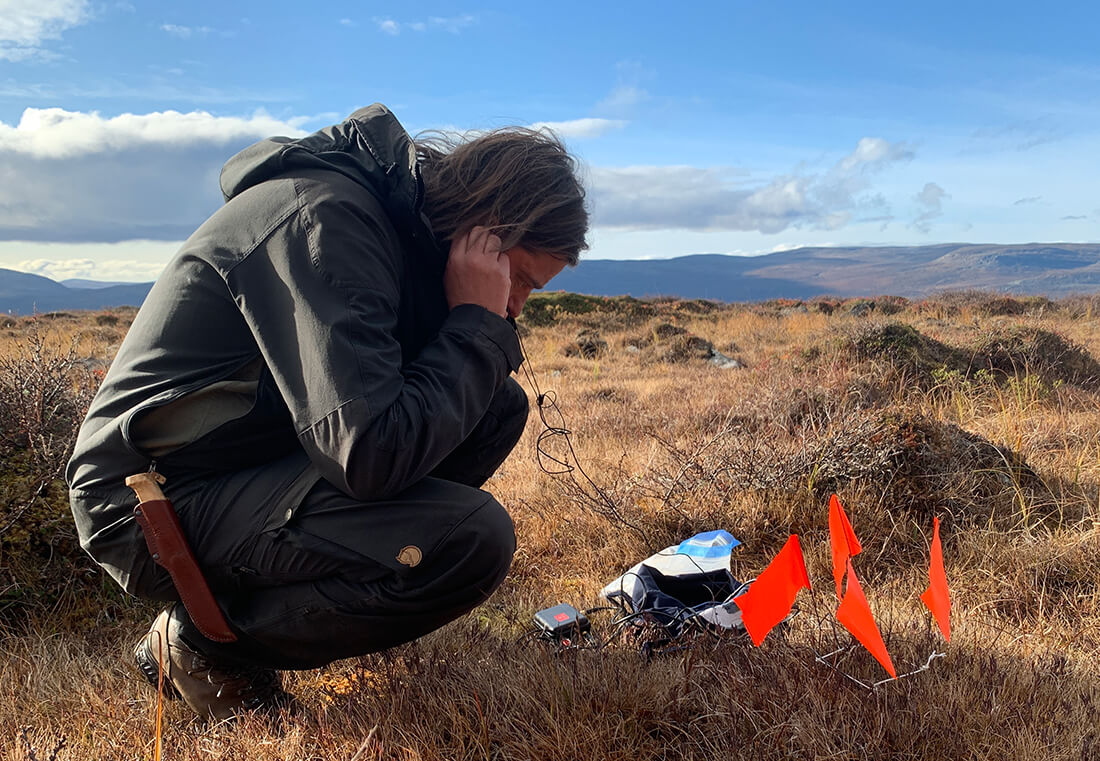
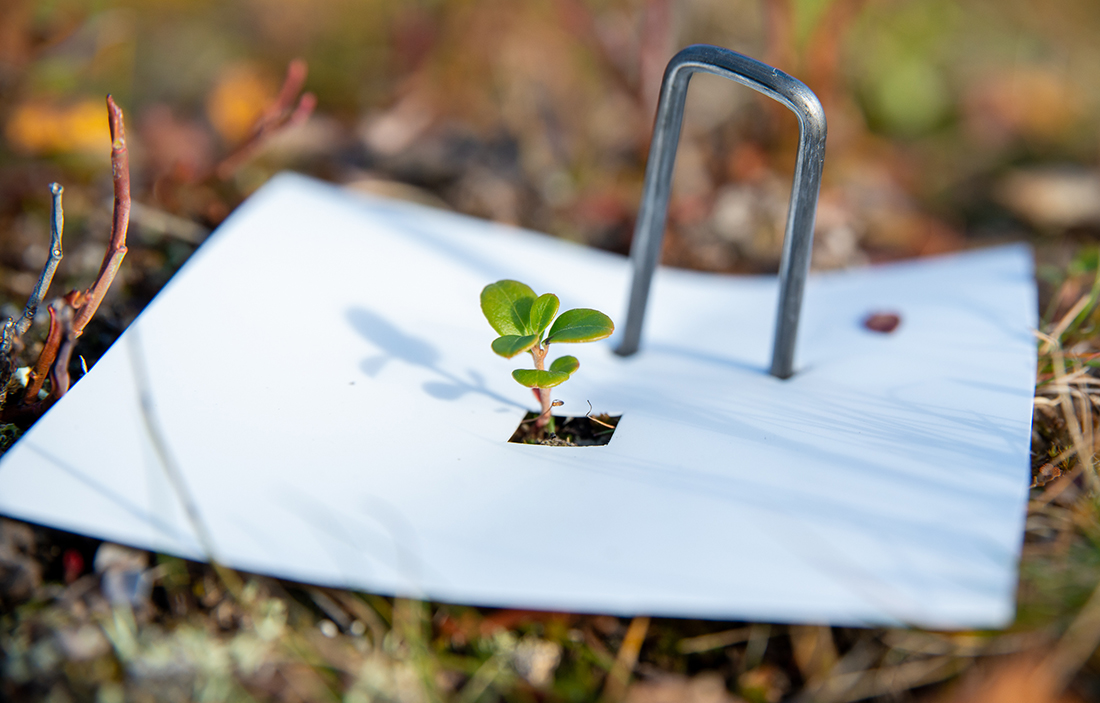
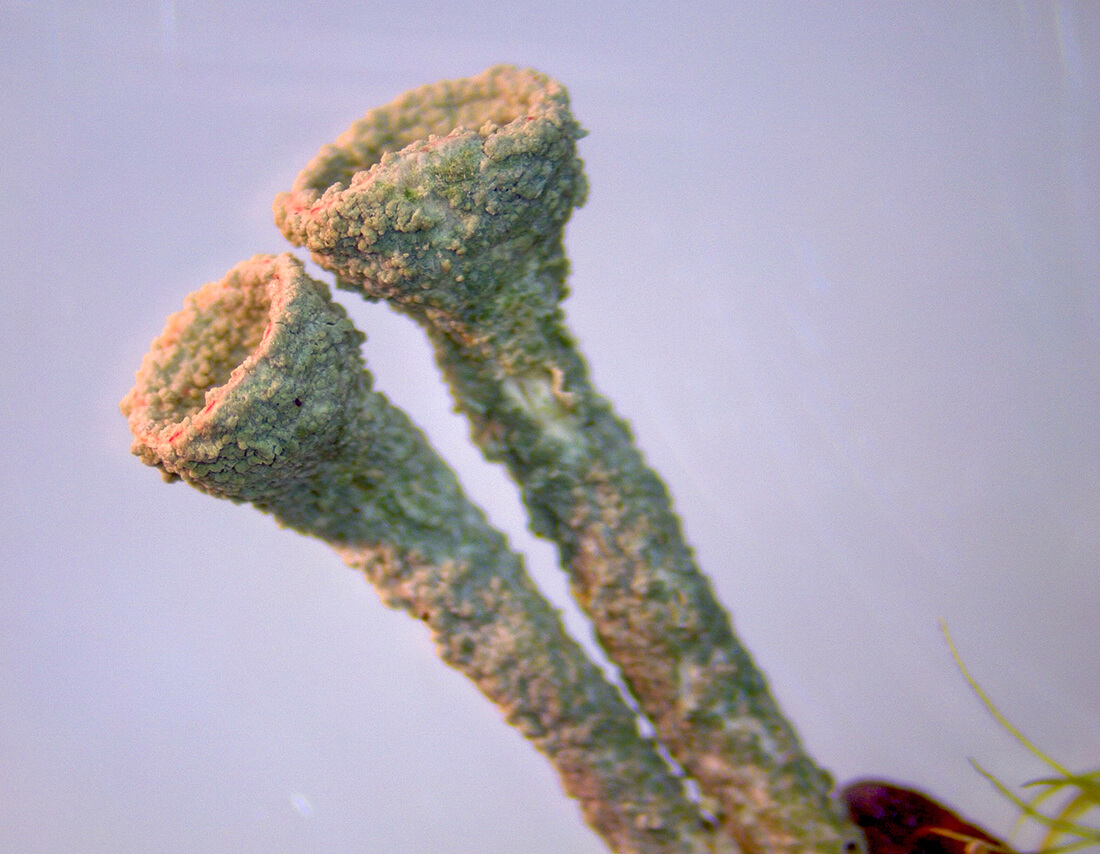
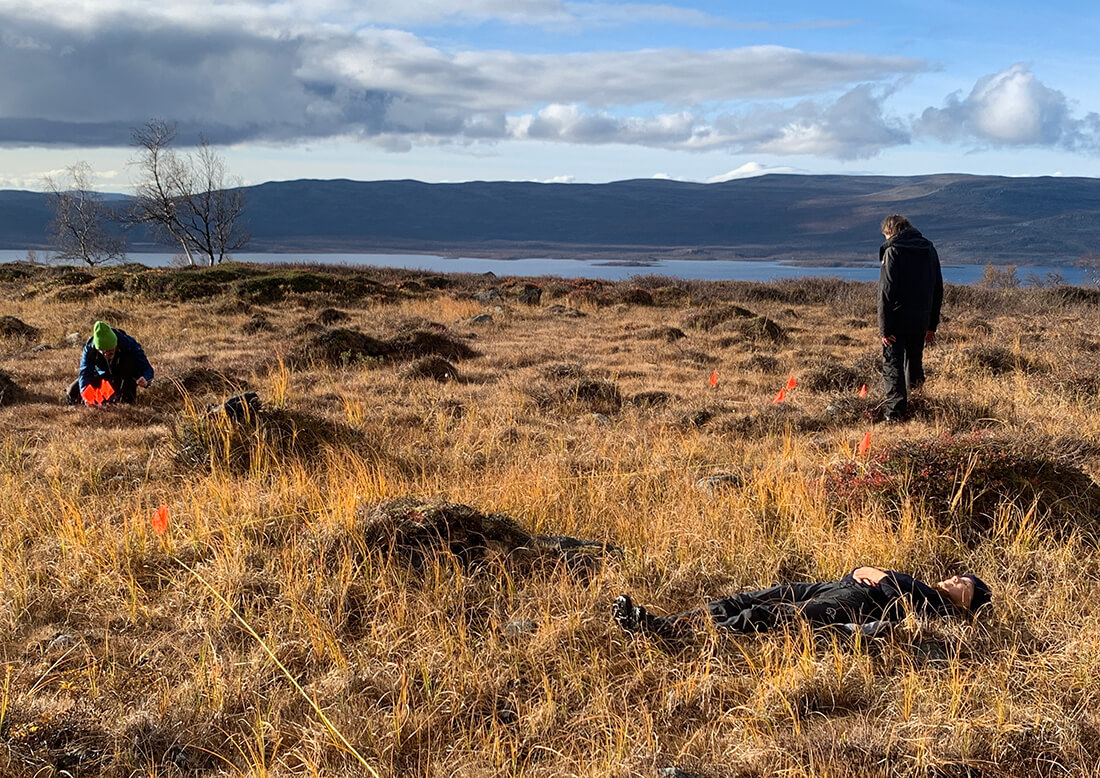
Attention, and the different containers and modes we find for it, shape the stories we tell ourselves about where and how we are and determine what stories we remember or lose. Demarcation anticipates measurement of some kind, but before the measurement comes attention. What if between the moment of gridding and the moment of evaluation, we elongate that period of attention – not the moment of hypothesis or judgment, but the moment when a place has come to one’s attention, has come to exist in relation with us, here, in our bodies, in a ‘thick present’ – a term Donna Haraway uses to describe a present that is densely interwoven with the past and future, filled with inheritances, rememberings, and possibilities (Haraway 2016). What if we adopt the square plots of zoologists and botanists to do something different? Use the grid as a shape to hold and grow attention rather than conquest – attention as a political act of storying space into placeness and care. A barnacling of lives, of heres, of nows that slip into the theres and thens that reenforce our kinships. Accounting for presences that empower accountability for other species. Attention is another way to find our way inside the outside.
Acknowledgements
Thank you to the Bioart Society, Luke Wolcott, Heikki Henttonen, Erich Berger, Till Bovermann, John Grzinich, Aleksi Jaakkola, Leena Lehti, Laure Winants, Lisa Kalkowski, Milla Millasnoore, Leena Valkeapää, Hannu Autto, Anu Ruohomäki, and Pirjo Hakala for making the projects in this text possible. Heartfelt thanks to Ulrik Ekman, Jenna Supp-Montgomerie, and Bennett Sims for your generous and tender readings and edits, which made this writing infinitely better.
References
Bovermann, Till. “The Station Activities” Bioart Society. 3 December 2023.
Haraway, Donna. 2016. Staying with the Trouble: Making Kin in the Chthulucene. Duke University Press.
Krauss, Rosalind. 1985. The Originality of the Avant-Garde and Other Modernist Myths. Cambridge, MA: MIT Press.
LIFEPLAN. “About” 2025.
McTernan, Elizabeth. “Andscapes” Bioart Society. 2023.
Morton, Timothy. 2013. Hyperobjects: Philosophy and Ecology after the End of the World. Minneapolis: University of Minnesota Press.
Stengers, Isabelle. 2018. Another Science Is Possible: A Manifesto for Slow Science. Cambridge: Polity Press.
Terranova, Fabrizio, dir. Donna Haraway: Story Telling for Earthly Survival. Icarus Films, 2016. 1 hr., 21 min.
